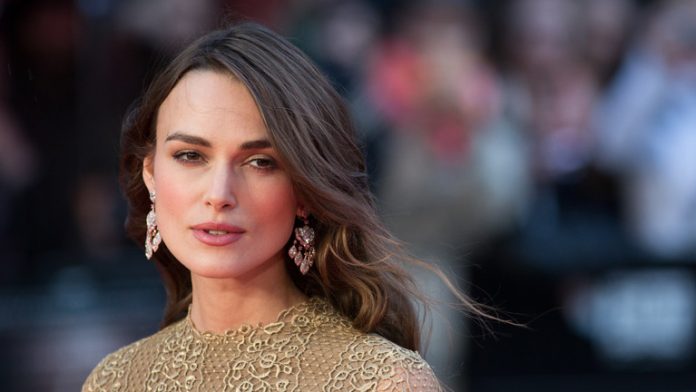Her identity-politics-driven beliefs regarding filmmaking are ill-informed and the antithesis of a genuine artist’s perspective.
Keira Knightley, best known for her roles in ‘Bend it Like Beckham’, ‘Atonement’, ‘Pride and Prejudice’, ‘The Imitation Game’ and the ‘Pirates of the Caribbean’ franchise, has made headlines by declaring that she has ruled out doing sex scenes directed by men and that she disapproves of the “male gaze” in cinema.
The two-time Oscar nominated actress told the director Lulu Wang on the Chanel Connects Podcast, “I don’t have an absolute ban [on filming nude scenes], but I kind of do with men… It’s partly vanity and also it’s the male gaze.”
The “male gaze” in filmmaking is defined by feminist theory as the act of telling a story and depicting women from a masculine, heterosexual perspective for the pleasure of a heterosexual male viewer.
Knightley certainly has the right to not do anything she doesn’t want to do, but her blanket dismissal of male directors due to some supposed insidious “male gaze” is laughably ironic, as one of the main reasons she became a big movie star is because she is so appealing to the “male gaze”.
Knightley has been very successful starring in films, mostly directed by men, that heightened her appeal, fed her vanity and maintained her dignity while not exploiting her in any way. This is what makes her newfound distaste for the male gaze, and male directors, so absurd.
It also makes her anti-male discrimination problematic when viewed in the wider context. Stripped of its self-reverential pro-feminist edifice, Knightley’s statement is an endorsement of blatant discrimination simply based on a director’s gender.
Would Knightley refuse to work with a master like Ridley Scott, who has made such great female empowerment movies as ‘Alien’ and ‘Thelma and Louise’, simply because he was a man and the role required a sex scene or nudity?
Would Knightley refuse to work with other genius auteurs like Paul Thomas Anderson, Steve McQueen or Alfonso Cuaron for the same reason?
Knightley further buttressed her gender-based discrimination stance by saying, “If I was making a story that was about that journey of motherhood and body [acceptance], I feel like, I’m sorry, but that would have to be with a female film-maker.”
Imagine if this gender-based litmus test were reversed and actors refused to work with female directors on more masculine projects like war films or male-driven stories.
According to Knightley’s myopic artistic worldview, Kathryn Bigelow, who won the Best Director Oscar in 2009 for her film ‘The Hurt Locker’, which tells the story of a man defusing bombs in the Iraq War, shouldn’t have directed that male-driven movie.
Knightley further explained her refusal to do a nude scene with a male director, “Because I’m too vain, and the body has had two children now, and I’d just rather not stand in front of a group of men naked.”
What makes Knightley’s anti-male director diatribe all the more absurd is the fact that the issue of on-set and on-screen nudity and sex scenes has been well examined in recent years to the point where having to “stand in front of a group of men naked” would never happen.
A year ago, the Screen Actors Guild published strict guidelines, standards and protocols that regulated sex scenes and nudity and required the use of professional “intimacy coordinators” on set.
Intimacy coordinators are tasked with making sure all sets where nudity or sex scenes occur are closed – meaning that only the bare essentials (no pun intended) in terms of crew are allowed on set and absolutely no one else. They also oversee rehearsals and confirm that all nudity and sex scenes included in the final cut of the film conform to what was agreed upon by the actors beforehand.
Maybe Knightley is unaware of all of the new precautions and protocols in place regarding on-set nudity since she has had a “no-nudity” clause added to her contracts since 2015, but even before then she wasn’t exactly known for doing a great deal of nudity anyway.
This is why her statements on the subject ring so hollow and feel so performative in nature. It is also striking that whenever Knightley mentions her vanity she quickly follows it up by tilting at the windmill of men or the male gaze in order to distract from her own shortcomings and play the victim/hero to an external imaginary villain.
In reality, Knightley’s anti-male director stance is quite nefarious, as it reinforces a worldview that puts the noose of identity politics around the neck of every artistic endeavor. This identity-based approach limits artists instead of empowering them, and ultimately will end up suffocating the creative process and any worthwhile art in the cradle.
Art should always and every time be a function of talent, skill, craftsmanship and passion… not identity. This talent-based approach allowed Leo Tolstoy to write ‘Anna Karenina’, straight actor Philip Seymour Hoffman to brilliantly play gay writer Truman Capote, Kathryn Bigelow to make ‘The Hurt Locker’ and a pasty white Englishman like Eric Clapton to play blues music invented by black men.
The identity-politics-fueled, gender-restrictive, artistic limitations that Keira Knightly is so shamelessly advocating should be anathema to any true artist, and her embrace of them ironically exposes her as nothing more than a vain and vacuous movie star.
































